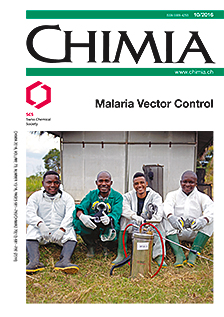Bivalent Carbamates as Novel Control Agents of the Malaria Mosquito, Anopheles gambiae
DOI:
https://doi.org/10.2533/chimia.2016.704Keywords:
Anticholinesterase, Catalytic site, Molecular docking, Peripheral siteAbstract
Widespread pyrethroid resistance has caused an urgent need to develop new insecticides for control of the malaria mosquito, Anopheles gambiae. Insecticide discovery efforts were directed towards the construction of bivalent inhibitors that occupy both the peripheral and catalytic sites of the mosquito acetylcholinesterase (AChE). It was hypothesized that this approach would yield a selective, high potency inhibitor that would also circumvent known catalytic site mutations (e.g. G119S) causing target site resistance. Accordingly, a series of bivalent phthalimide-pyrazole carbamates were prepared having an alkyl chain linker of varying length, along with other modifications. The most active compound was (1-(3-(1,3-dioxoisoindolin-2-yl)propyl)-1H-pyrazol-4-yl methylcarbamate, 8a), which has a chain length of three carbons, good mosquito anticholinesterase activity, and ca. 5-fold selectivity compared to human AChE. Moreover, this compound was toxic to mosquitoes by topical application (LD50 = 63 ng/female) with only 6-fold cross resistance in the Akron strain of Anopheles gambiae that showed 50- to 60-fold resistance to conventional carbamate insecticides. However, contact lethality in the WHO paper assay was disappointing. The implications of these results for design of new mosquitocides are discussed.Downloads
Published
2016-10-26
Issue
Section
Scientific Articles
License
Copyright (c) 2016 Swiss Chemical Society

This work is licensed under a Creative Commons Attribution-NonCommercial 4.0 International License.
How to Cite
[1]
Chimia 2016, 70, 704, DOI: 10.2533/chimia.2016.704.







